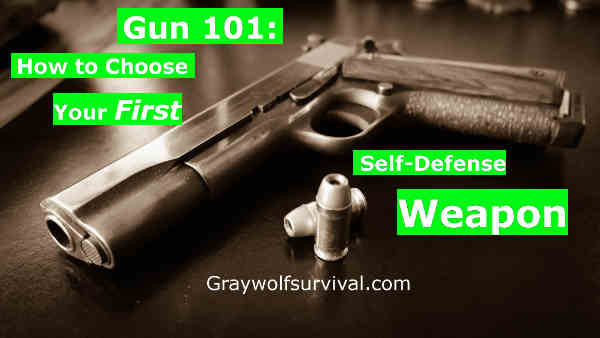 Let me preface this article by saying that the information contained is for beginners; for those just getting into prepping or even new to firearms. Call it a “Guns 101
Let me preface this article by saying that the information contained is for beginners; for those just getting into prepping or even new to firearms. Call it a “Guns 101” or “Firearms for Dummies” type article. So if you have firearms and related experience, you might want to skip this. Unless of course you are bored, or you really love reading what I write.
For those of you who are considering purchasing your first firearm for self-defense, you need to do something. The first thing you need to do, before rushing to a gun store or even looking online, is to stop and think for a bit. You need to ask yourself this VERY SERIOUS question.
Could you pull the trigger if you had to? Could you possibly take another human life?
Don’t blow this off. This is of utmost importance.

What’s in your home defense system?
If you have some doubts now about whether or not you could potentially kill another human being should you be in an life threatening event, those doubts will most likely be compounded and magnified in a high stress incident.
Many times people react to highly stressful situations much differently than how they anticipate they would. Some people may “freeze up”, hide, or run. The whole “fight or flight” thing kicks in.
Unfortunately for many people, they don’t know how they will react until the event is happening. But like I said, doubts now are a good indicator of what you might possibly do in those events.
“Even if I can’t bring myself to pull the trigger, I could get a gun and just hold it. The threat of a gun will scare them off!” you say.
This is NOT a good idea. While the mere sight of a gun is often time enough to send a criminal fleeing, there are times where the sight of a gun could escalate the situation. The bad guy may try to take it from you, or worse, he may pull out his gun. And in that case, chances are strong that he WILL pull the trigger resulting in a very bad day for you.
So if you are not reasonably sure you could pull the trigger if you had to, you should seriously reconsider whether or not to purchase a firearm.
I’m assuming that since you are still reading, you have thought it out and decided that if you and or your friends/family were in danger, you could defend yourself with deadly force. So let’s move on to the next step.
First, determine what sort of firearm you want. Do you want a pistol that you can conceal for self-defense? Were you thinking shotgun? Rifle? Figure out what your reasons are for having a firearm, and go from there. There are pros and cons to all, so YOU have to determine what is best for you.
Pistols are obviously much easier to conceal. Rifles are much better for shooting at a distance. Shotguns are the most versatile. Determine what you need, and what will work for you based upon your situation.

My loyal companion
My home defense system involves a Remington 870 Police Magnum (as pictured above) with Federal 12 gauge power shok #4 Buck. (The other part of my home defense system includes my loyal companion.) But again, this is my personal preference and what works for me based upon my living arrangements.
Now you might have viewed a bunch of Youtube videos, or read other articles telling you what guns you need for home defense or as a prepper. They may tell you what calibers (bullet size) you should get or to avoid.
Throw that out the window.
When it comes to firearms or calibers, what is most important is what YOU feel comfortable with. A 44 magnum (think Dirty Harry Callahan) won’t do you much good if the gun is unwieldy, the recoil is too much for you, or you simply do not feel comfortable with it. I promise you, a .22 caliber bullet (one of the smaller bullets out there) can be just as deadly as a hand grenade in the right situation. I mean, the end result is, well…dead.
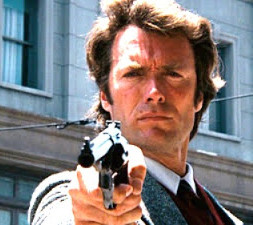
Several years ago, my now ex-girlfriend decided that she wanted to get her carry conceal license, and she wanted to purchase a pistol. She had shot my mid-sized Glock before, but I thought she would do well with a snub nosed .38 revolver. In my mind, it was small enough to fit in her purse, wouldn’t jam, and it had enough “stopping power” should she have to use it.
We went to a local gun range where we could rent firearms, and I rented her a Smith and Wesson revolver. But after 3 or 4 shots, she turned to me and said “I don’t like it.”
She explained to me that she just didn’t feel comfortable with it, and she liked shooting my Glock more. So while I fired off the rest of the ammo for the revolver, she sent a bunch more lead down range from my Glock.
In the end, she got her carry conceal license, bought a Glock, and we eventually went our separate ways. But I realized that what I thought would suit her didn’t matter. It was what SHE felt comfortable with. And the same is true for you.
So before you buy anything, I’d encourage you to shoot some different firearms and different calibers. See what feels right for you. If you can’t find a gun range that will allow you to test fire, see if you have friends or co-workers who shoot, and tag along with them.
Once you have reached a point where you feel reasonably certain of what you want and are ready to head to a gun store, let me give you a few tips. These are tips that I have learned from personal experience. I purchased my first firearm at the ripe old age of 21. And all the knowledge and training I had at that point was gleaned from Clint Eastwood movies. Seriously.
I wish I knew then what I know now. It would have saved me plenty of money.
The first thing I’d say is to buy a new firearm. While there are plenty of quality guns that are used and obviously cheaper, there are also plenty of unscrupulous dealers out there. There could be issues or problems with the gun that you are not aware of. And they could be small enough that the untrained eye would not notice them. So until you have more experience and know what to look for, I would stick to getting something brand new.
In addition, most firearms have a manufacturer’s warranty. (Be sure to ask about that when purchasing.) If something goes wrong with your gun, it can be fixed or replaced usually at the manufacturer’s expense. But with a used gun, the warranty may be expired. Or the previous owner may have done something to the firearm which voids the warranty. (Some gun modifications can void a warranty on a firearm.)
If you do buy used, make sure it is from a person you trust. Below is a video on how to purchase a used pistols if you feel that is the route you need to take. Again, you know your circumstances better than anyone. (I watched the video, solid info in my opinion.)
The second tip would be to stick to common calibers. At the age of 21, I decided I wanted a “Dirty Harry gun”, a 44 magnum. And that was the extent of my knowledge. So I went to a gun show with the intent of acquiring such a revolver.
The first booth I found that had 44 mags, I was excited…until I saw the price tag. OUCH! I was a poor struggling college student. And although I had some money burning a hole in my pocket, I didn’t have THAT much.
“Not to worry” said the man in the booth. He had a used 44 Special. Almost the same thing…right? The bullets are close to the same size. (For the record, a 44 mag will shoot 44 special rounds, but not vice versa.) And on top of that, since it was my first gun, he would throw in a box of rounds for FREE!
What college student doesn’t love FREE?
Needless to say I was tickled pink with my purchase, and within a few days I was at the range. I pulled the trigger, and it went bang every time. No issues…until I ran out of bullets. The employee at the range didn’t generally carry 44 special rounds. In fact, the only store I could find that did was 20 miles away from my house!!?! And to make matters worse, I had no idea how expensive that ammo was. (In terms of a poor struggling college student.)
Well this sucks!
Ok…time to rethink my plan. The guy at the range seems to have plenty of .357 ammo. While it is still expensive, it is cheaper than 44 special. So at the next show, I’ll trade the 44 special for a Rossi .357 magnum. (I’ll let you guess who got the better end of that deal.)
Anyway, my point is that I’d stick to calibers that are common and usually plentiful. For handguns, .22lr, 9mm, 40 cal, .357, and 45 APC. For shotguns 12 gauge is the most common. But 20 gauge and .410 are also easy to find. For rifles, .223/5.56 and .308 are probably the most common in the US. 30-06 and .270 are also readily available. (.22 is also available in rifles.)
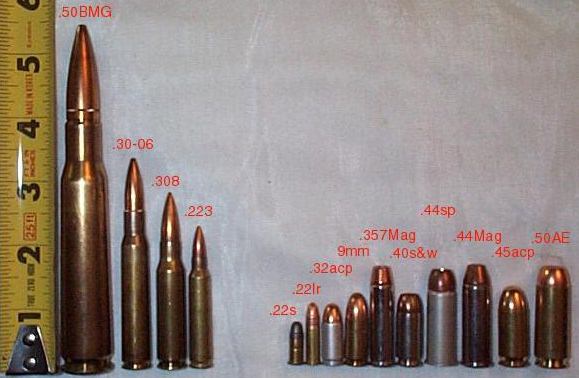
Hopefully this will give you an idea of come common calibers, pistol ammo on the right, rifle on the left.
I am not discounting other calibers I did not mention. There might be other calibers not on my list that are plentiful. I’m simply giving you some ideas.
My next tip, and I have mentioned about getting what you pay for in other articles, is to budget yourself for a decent, quality firearm. To me, when it comes to firearms, quality matters. Your life may someday depend on it.
About a year or so after I acquired my Rossi .357, I realized that in the movies, the action heroes were all carrying semi-automatics. That must mean that the revolver is old and outdated. I had to get with the times and get a semi-automatic. (Oh to be young and naïve again.)
Unfortunately, the money burning a hole in my pocket was not quite as large a sum as the last time. So I was basing my decision almost solely upon the price. I found a semi-auto that I could easily afford. I determined its caliber, and then walked around the gun show. That caliber bullet seemed to be available, and was cheaper than .357. (See? I had learned my lesson from the 44 special.)
I left the gun show confident with my Bryco/Jennings .380. The fact that it cost me only $100 should have been a clue.
For those who are new to firearms, a Bryco/Jennings (now Jimenez Arms) firearm is quite possibly the cheapest firearm on the market. Remember the old Pontiac Fiero? Fun to look at, but otherwise a hunk of junk? Yep….that’s a Jennings. (You can read here about the lawsuit filed and won over design flaws with this pistol.)
I quickly learned that cleaning it was a pain in the ass because it was VERY difficult to field strip. It wasn’t always reliable and sometimes had problems with ammo jamming. In the end, I put maybe 500-600 rounds through it. I didn’t like it so I didn’t shoot it much. It stayed in a shoe box in my closet for years.
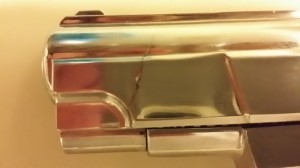
Junk!
A year or so ago, I gave it to my brother. He put maybe 200 rounds through it before the frame cracked. Yes, that is a picture of it. Less than 1000 rounds through it. Junk!
I’m not going to get into “which manufacturer is better” debate. What’s the point? Everyone has their opinion and in the end it is up to YOU. But I would encourage you to stick to a brand that has a solid reputation. You have the benefit of the internet and Youtube. Do some research. Try out different manufacturers before purchasing one. Shoot a Glock, a Smith& Wesson, a Springfield, etc and decide which one works for you.
Remember, this is an investment that could save your life someday.
My last tip is this; practice! Just because you made a purchase you are happy with, and managed to put some rounds down range without shooting your eye out does not mean you are good to go. You need to build your skill level up. You do this by spending time at the range practicing.
Remember when I talked about not always knowing how you would react in a high stress situation? Well practice and repetition help to build confidence. And those things will help to determine how you react if you find yourself in a life threatening event.
Purchasing a firearm can seem like a daunting task. Hopefully by reading this you feel a bit more comfortable. Feel free to post any questions in the comments below. Myself and Graywolf would be more than happy to answer them.
If you would like to read more on prepper firearms, click here for the follow up article. I try to go a bit more in depth on EDC and home defense firearms. In Part II, I cover firearms for a long term survival scenario.
For tips on long term ammo storage, click here.
You can reach me by email at planandprepared@gmail.com
—
Here are some more resources that can help you figure out what would be the best self-defense weapon for you:
Guns 101: A Beginner’s Guide to Buying and Owning Firearms
With a background in firearms instruction, sales, and organizations, Steier’s knowledge has been cultivated through years of in-depth experience and personal dedication. In Guns 101, Steier covers the basics (what guns are for and how they work), but also discusses many types of firearms, firearm accessories, and gun activities—enough to help any reader carry on an intelligent conversation. From shop etiquette to do-it-yourself repairs, Guns 101 answers all of your gun questions. Complete with diagrams and photographs that make all of the technical details clear, this book is essential reading for any newcomer to the world of guns.
————————————————————————
————————————————————————
The Gun Guide for People who Know Nothing About Firearms
The problem with talking about firearms is that people tend to be either gun nuts or they’re totally ignorant and/or scared to death of firearms. If you’re a novice and try to find answers online you’re soon flooded with divergent opinions, conflicting advice, and sometimes ridicule for asking such “stupid” questions. This book takes those who are new to the world of firearms and explains the basics of how firearms work, the strengths and weaknesses of every major type of firearm you’re likely to encounter, and in the final section, shows you how to evaluate firearm and ammunition choices. When you’re finished reading this book you’ll be equipped to make an informed purchase that takes into account your budget and your needs.
————————————————————————
Getting Started with Firearms in the United States: The Complete Guide to Firearms for Newbies
In this book, Nick Leghorn (writer at The Truth About Guns, the most popular firearms blog on the internet) explains the basics of firearms ownership to new shooters. Using simple easy-to-understand descriptions and some of his famous humor Nick explains everything from what a firearm is and how it works to proper gun store etiquette and how to buy your first gun.
Please share this article if you know someone who’s thinking about getting a firearm for home or self defense.






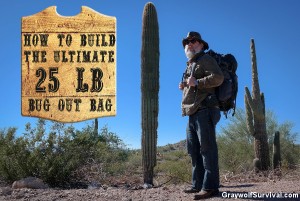

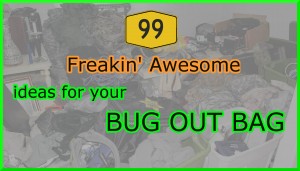
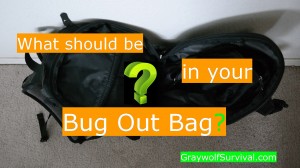
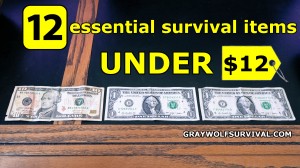

Excellent article … after talking with experts, two items, are a 357 revolver .. very basic, not many working parts, easy to clean, i.e. dummy proof … and a pump action 12 gauge shotgun , my personal favorite being the mossberg line
Excellent article. I agree that the 870 pump shotgun loaded with #3 or #4 buckshot is the best for home defense. I prefer 20 gauge instead of 12. Less recoil in close quarters.
I also think the 20 gauge is a better idea for beginners.
“Could you possibly take another human life?”
Along with this question, the person should also ask himself, “Could you simply stand by and watch your loved ones raped and killed, because you were too much a pissant to get a gun?”
I think the self-examination can be overdone, though. People should just get a gun and give it a try. They might find, after a little familiarity, even with bumbling steps such as the author’s, that they have progressed to the point where they *could* take another life if necessary. People do learn and adapt. That is what humans are best at.
The good thing much like PJ says, 20 gauge is good stuff to consider.
I remember a Massad Ayoob article where he covers the topic… 75% of the firepower of a 12 gauge but 50% of the recoil, a very worthwhile tradeoff.
I’d suggest you read the book “On Killing” by Lt. Col. Dave Grossman. Killing another human being is not as easy as you might think….unless you are a complete psychopath.
I think another big consideration is WHERE you plan on using the defensive arm, not everyone has a house big enuff to swing a shotgun around in, and if you have neighbors you pretty much need to rule out rifles altogether unless you buy Glaser Saftey Slug ammo, which is really pricy, as most everything else can very well penetrate multiple walls unless ya live in a log home!
Recently I have taken an interest in home defense & preparedness. Thanks for the tips on your site. Very helpful. Might I make a suggestion to the newcomer females (or males for that matter) thinking about buying a gun?
First I went to the CCW classes and got licensed. Then I joined the NRA. Through these avenues I learned more and more, not only about the laws, but all sorts of things I didn’t even know to ask. Then I searched for local training. I was ecstatic to find a local gun club & joined for a nominal fee. I go to the range regularly where I find very helpful members who are more than happy to answer questions and give me helpful tips. One of their main purposes is education & safety. Not only do I feel comfortable owning & carrying a firearm, I now thoroughly enjoy shooting! I want to be a safe, responsible gun owner, not another story in the news for gun rights opponents to use.
You told everything….lol….i made the same mistakes….
I started with a Taurus .357 “3 barrel model 66 from the 80’s (still have it) and soon i realized that i should kept the money and bought something smaller and better suited to me. I’m not saying that my Taurus is bad, until now, it never let me down in the range but a smaller one to carry would been better, so i bought a Manurhin PPK 7.65 (.32) that i still use. One day a friend of mine let me shoot some rounds with a Beretta 82 fS (.32) and of course now is the weapon i use daily. Cheap ammo, larger magazine, a bit bigger than the PPK but very accurate, reliable and comfortable to handle.
Since I was fairly new at everything, my first gun besides the 9mm luger left by my ex forgetting it was a 12ga Mossberg. Sine I don’t know zip about shooting or aiming the little old man at the Gun shop recommended it. Mean looking black thing but I could pick it up AND handle the slide. For whatever reason it has now become my fav possession. Ty for your insights n information. Spot on! As usual!!
I’m Canadian. eh. Living in a country where only law enforcement and crooks carry, let alone carry concealed, and home defence given as a reason for gun ownership will get you refused from licence acquisition; choices become somewhat limited. My personal preferences are two excellent “varmint” or “small game” shooters – Ruger 10/22 rifle and Remington 870 shotgun.
Iam pushing 74 years and have been around weapons all my life. my early years was a 22 single shot winchester still my favorite at a hundren yards. after the army it was a 870 remington 12 ga. pump 20 inch barrel with rifle sites. a slug gun. still got that one too but very hard for me to shoot today its a kicker. had a lot of pistols always bought trade names besides my 1911 I have 3 22 pistols the favorite being its a highstandard no parts double action western 51/2 inch barrel and hits the target at hundren yards and shoots two cal. 22s and 22 mag. old but nice. then there my 22 colt auto woodsman 1939 this will fire off a 11 shots in about 3 second. what more you need. keep what you need. sell the rest. yes I wanted a dirty harry pistol never got one.
it was good to read this post. Thank you for your service.
Thank you, Dalton!
Thank you. Thank you. Thank you. I don’t particularly like guns but I feel I need it for defense. I wasn’t sure where to start. You’ve helped me tremendously.
this is a very good site well covered. my cousin who is 85 use a baseball bat and a real swinger. I have two chainsaws and four axes the smallest being a voager one pounder with a seventeen inch handle. indians liked this the best. knifes with 10 inch blades . board with a large nail at the end. a sharp stick works. gasoline diesel and dishsoap in a quart jar with a rag coming out the top of lid is really hot when lit and throw. I am saying this for when the ammo gone or they have took are weapons away. Graywolf I know you are busy with your own life. and this site. but a chapter on weapons when there none. or do I have to stick you with a safty pen or ahat pen. everything a weapon. I like bike spokes. act U puncher works.
That’s nice. The article is called “Gun 101”. I think the idea is to get comfortable firearms so that when it comes time defend yourself and/or family you’re not reduced to using a sharp stick or a board with a nail in the end. Improvised weapons are well covered elsewhere on the web, and in various field manuals the Graywolf recommends. Just a thought, but if you’re down to tomahawks and bicycle spokes it’s probably time to run, not fight.
really useful information
Thank you
I think you can’t overstress “carry ability.” If you aren’t wearing the gun when you need it, then none of the other factors matter. I recently switched from Glock 19 to Glock 26 for everyday carry and there is a big difference in my desire to wear the gun every day. It’s just more comfortable.
I’m a pan-generational prepper, from where my people come from life has always had higher elements of risk – Americans are so f*ing naive. In your list of things on gun consideration I notice some gaps. The .22LR is mandatory, and for a home defense issue you seem to be missing.
The plague is still active in the world. Rats, squirrels, rabbits can carry it. Repeatedly in the past century the US had plague epidemics. In the 1920s Los Angles outbreak they discovered it was probably spread by rats. They hired bounty hunters to eliminate them. Now we rely on the county or city public health agencies.
For pest control you can rely on them, you can pull our your Glock or 1911, or you can plink them with a 10/22 at about 2 cents a round.
I strongly recommend “The Pandemic Century” for a read.
My bug out plan is to hunker down. If you don’t have a WW II folding spade in your kit you need to add one. You also need to deal with water purification more realistically. Viruses and Bacteria will kill you much more certainly than armed combat.